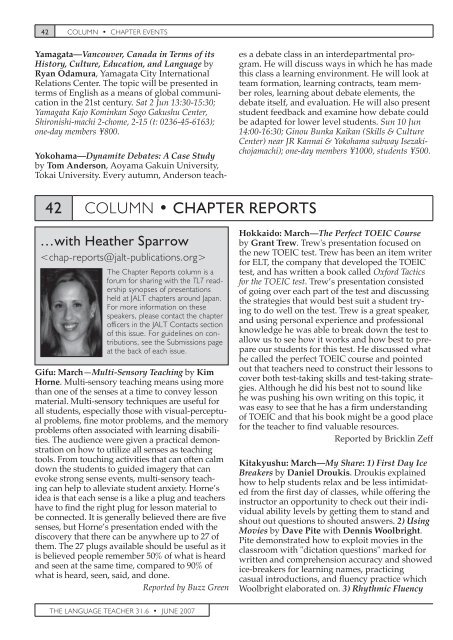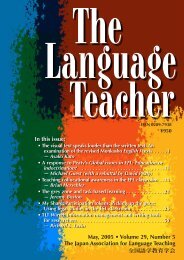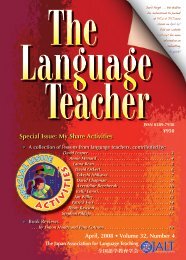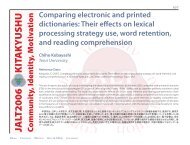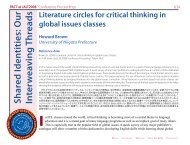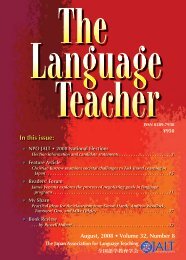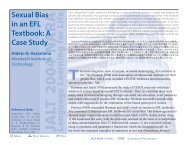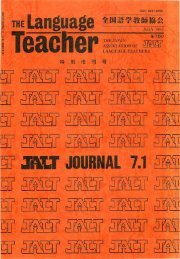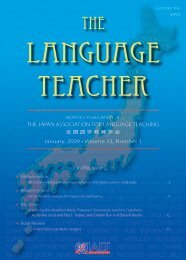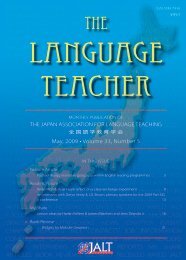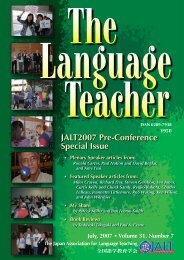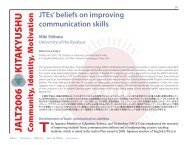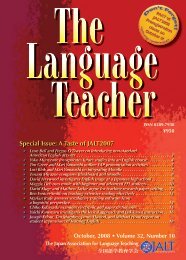In this issue: - JALT Publications
In this issue: - JALT Publications
In this issue: - JALT Publications
Create successful ePaper yourself
Turn your PDF publications into a flip-book with our unique Google optimized e-Paper software.
42 Column • Chapter EventsYamagata—Vancouver, Canada in Terms of itsHistory, Culture, Education, and Language byRyan Odamura, Yamagata City <strong>In</strong>ternationalRelations Center. The topic will be presented interms of English as a means of global communicationin the 21st century. Sat 2 Jun 13:30-15:30;Yamagata Kajo Kominkan Sogo Gakushu Center,Shironishi-machi 2-chome, 2-15 (t: 0236-45-6163);one-day members ¥800.Yokohama—Dynamite Debates: A Case Studyby Tom Anderson, Aoyama Gakuin University,Tokai University. Every autumn, Anderson teachesa debate class in an interdepartmental program.He will discuss ways in which he has made<strong>this</strong> class a learning environment. He will look atteam formation, learning contracts, team memberroles, learning about debate elements, thedebate itself, and evaluation. He will also presentstudent feedback and examine how debate couldbe adapted for lower level students. Sun 10 Jun14:00-16:30; Ginou Bunka Kaikan (Skills & CultureCenter) near JR Kannai & Yokohama subway Isezakichojamachi);one-day members ¥1000, students ¥500.42 Column • Chapter Reports…with Heather SparrowThe Chapter Reports column is aforum for sharing with the TLT readershipsynopses of presentationsheld at <strong>JALT</strong> chapters around Japan.For more information on thesespeakers, please contact the chapterofficers in the <strong>JALT</strong> Contacts sectionof <strong>this</strong> <strong>issue</strong>. For guidelines on contributions,see the Submissions pageat the back of each <strong>issue</strong>.Gifu: March—Multi-Sensory Teaching by KimHorne. Multi-sensory teaching means using morethan one of the senses at a time to convey lessonmaterial. Multi-sensory techniques are useful forall students, especially those with visual-perceptualproblems, fine motor problems, and the memoryproblems often associated with learning disabilities.The audience were given a practical demonstrationon how to utilize all senses as teachingtools. From touching activities that can often calmdown the students to guided imagery that canevoke strong sense events, multi-sensory teachingcan help to alleviate student anxiety. Horne’sidea is that each sense is a like a plug and teachershave to find the right plug for lesson material tobe connected. It is generally believed there are fivesenses, but Horne’s presentation ended with thediscovery that there can be anywhere up to 27 ofthem. The 27 plugs available should be useful as itis believed people remember 50% of what is heardand seen at the same time, compared to 90% ofwhat is heard, seen, said, and done.Reported by Buzz GreenHokkaido: March—The Perfect TOEIC Courseby Grant Trew. Trew's presentation focused onthe new TOEIC test. Trew has been an item writerfor ELT, the company that developed the TOEICtest, and has written a book called Oxford Tacticsfor the TOEIC test. Trew’s presentation consistedof going over each part of the test and discussingthe strategies that would best suit a student tryingto do well on the test. Trew is a great speaker,and using personal experience and professionalknowledge he was able to break down the test toallow us to see how it works and how best to prepareour students for <strong>this</strong> test. He discussed whathe called the perfect TOEIC course and pointedout that teachers need to construct their lessons tocover both test-taking skills and test-taking strategies.Although he did his best not to sound likehe was pushing his own writing on <strong>this</strong> topic, itwas easy to see that he has a firm understandingof TOEIC and that his book might be a good placefor the teacher to find valuable resources.Reported by Bricklin ZeffKitakyushu: March—My Share: 1) First Day IceBreakers by Daniel Droukis. Droukis explainedhow to help students relax and be less intimidatedfrom the first day of classes, while offering theinstructor an opportunity to check out their individualability levels by getting them to stand andshout out questions to shouted answers. 2) UsingMovies by Dave Pite with Dennis Woolbright.Pite demonstrated how to exploit movies in theclassroom with "dictation questions" marked forwritten and comprehension accuracy and showedice-breakers for learning names, practicingcasual introductions, and fluency practice whichWoolbright elaborated on. 3) Rhythmic FluencyTHE LANGUAGE TEACHER 31.6 • JUNE 2007


